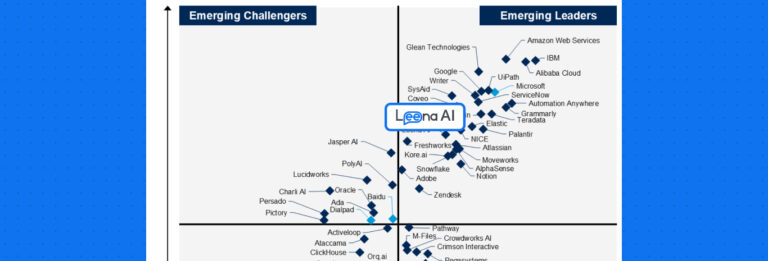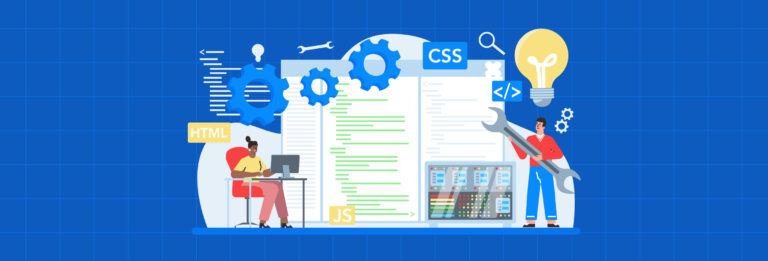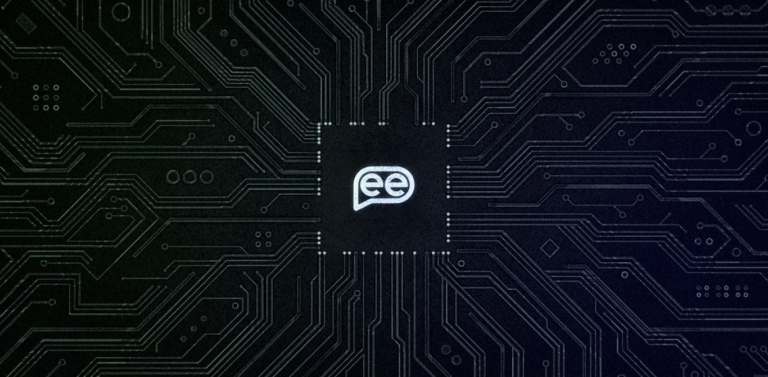The coronavirus pandemic disrupted the world of work during 2020. Both, organizations and employees, had to adapt to the changes and adjust to the new way of working, in some companies practically overnight. Further, millions of people lost their jobs, and teams all over the world rapidly moved to work from home as offices closed.
Now, after almost 2 years, with the coronavirus cases subsiding and countries opening up, many companies are looking forward to returning to the workplace while carefully treading the path towards health and safety.
While some love the idea of face-to-face collaboration with colleagues and working from a dedicated workspace, others are worried about the transition. Most of us have learnt to enjoy the safety and flexibility of remote work so much that we’d only like to return to office if our employers insist on it. On top of that, they are concerned about losing the benefits of working remotely—increased productivity, a relaxed schedule, and zero morning commute.
Amidst the mixed emotions surrounding returning to work, HR leaders are slowly realizing that the return to work is as much a human challenge as it is a logistical challenge.
While it’s clear that Covid-19 has changed the future of work forever, employers need to create a new work environment that will keep employees productive, happy, and, most importantly, safe.
That’s exactly what we’ll discuss in this guide.
This guide will walk you through future workplace trends such as the implementation of the hybrid work model, automation and the future of work, recent discussions around employer vaccine mandates, and what companies are doing to ensure a safe return to workplaces for their employees, through health record management systems and Covid vaccination tracker.
Trends Shaping the Future of Work: Hybrid Work Model
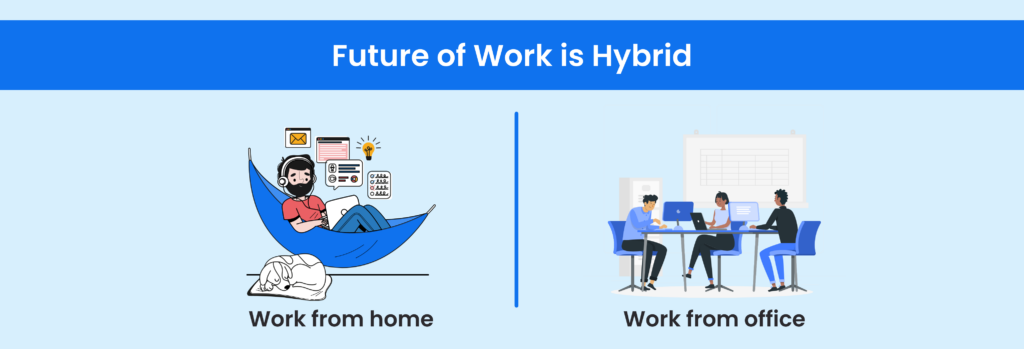 Before the pandemic, most employees worked from the office, which was the norm—working from 9 to 5, five days a week. Once Covid-19 hit, they rapidly pivoted to remote working with little or no planning, and even the most reluctant employers were forced to consider the new working options. Covid-19, in essence, accelerated the move to the future of work a few years in advance.
Before the pandemic, most employees worked from the office, which was the norm—working from 9 to 5, five days a week. Once Covid-19 hit, they rapidly pivoted to remote working with little or no planning, and even the most reluctant employers were forced to consider the new working options. Covid-19, in essence, accelerated the move to the future of work a few years in advance.
Remote working has skyrocketed during the pandemic and shows no signs of slowing down. Workers and organizations alike are enjoying the cost-effective and productivity-boosting benefits of the work from home (WFH) model.
However, some businesses and employees still see the perks of having an in-house team, such as social interactions, face-to-face collaboration with colleagues and clients, brainstorming in in-person meetings, and so on.
Thankfully, there’s a way to make the organization and employees happy—a hybrid work model that considers all the needs and work styles.
What is a hybrid work model?
A hybrid model is a flexible working model that allows employees to work remotely and on-site on chosen days of the week or month. In other words, it offers the best of both worlds. It combines the benefits of working from home and office—employees who want to stay home can work remotely, and those who miss the office environment can commute in with proper safety in place.
Many organizations (such as Google, Slack, Spotify, Shopify, and IBM) have started rolling out this model for their workers and are experiencing increased employee satisfaction and productivity rates. The tech giant Microsoft has allowed its current employees to work from home for 50% of their workweek, with an option to go fully remote with the management’s approval.
The hybrid work model is categorized into four types, that differ according to the industry or role:
- At-will model: This model enables employees to choose the work arrangement at their convenience. It works best for employees who want to come into the office to meet someone or require a dedicated workplace to work for a day.
- Split-week model: This style divides the work week between working on-site two to three days a week and remotely two to three days a week. It’s beneficial for those employees who want to experience the benefits of working from both on-site and home. Plus, it allows managers to stay in touch with their team and hold face-to-face group meetings regularly.
- Shift work model: In this model, employees work in shifts, such as working from home in the morning and working afternoon or evening shifts on site.
- Week-by-week model: The fourth model allows employees to alternate work from home and office on a weekly basis. It is the best option for employees located far away from the office so they can travel one week and take the next week off from their commute.
What Are the Benefits of A Hybrid Work Model?
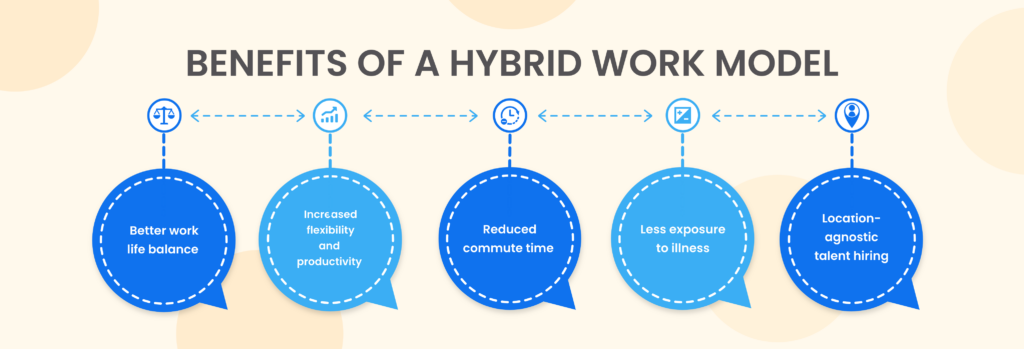
Let’s look at some of the advantages of the hybrid model for employees and organizations:
Increased flexibility and productivity
Some employees need to focus quietly at home, while others thrive better in an office environment. Because the employees aren’t expected to work from 9 to 5, the hybrid work model gives more flexibility to do their tasks when and how they’re most productive.
Further, the hybrid style gives employees the choice to come into the office whenever they want, either due to distractions at home (such as poor connectivity, interruptions from small children, or unsuitable living conditions), their personal preferences, or to discuss something face-to-face with their co-workers. This way, employees can work from the location where they’ll get to do their best work.
Better work-life balance
A hybrid model provides the option to work outside the 9 to 5 setup, offering better work-life flexibility. According to research, 9 out of 10 professionals feel hybrid working is essential for work-life balance. Further, 48% stated that the hybrid framework allows them to devote equal time to their personal and professional goals.
Employees can make their own schedule, giving them a remarkable amount of freedom throughout the workday. They can have more time to make a healthy dinner, pick up kids from school, join a yoga class, or meet friends on a lunch break.
Reduced commute time
Whether it takes 15 minutes to drive to work or one hour, a hybrid schedule can directly cut the commute time of the employees. They can start their workday earlier if they don’t waste their time on stressful commutes, resulting in increased productivity and better results. Plus, they get more time to spend on hobbies and reduce carbon emissions because of less travel to work.
Less exposure to illness
You might encounter hundreds of people while traveling to work by train, bus, or subway. So, having the option to work remotely reduces the unnecessary commute and lessens the risk of illness.
Further, by reducing the number of employees in the workplace, companies can ensure that sick people stay at home (without taking any extra leave) and lower the chance of cold, flu, or even Covid spreading around the workplace. Ensuring social distancing and proper health screenings for employees coming to the office can also avoid spreading this deadly virus.
Hire talent across the globe
In a hybrid work model, when you open roles to global candidates, you can hire talent from all around the world with exceptional skills. It doesn’t matter if the individual lives in a different city or country. This can give your company an edge over competitors, help you tap into new markets, and ensure round-the-clock productivity during peak hours in different time zones.
The value of a hybrid model
The future of work isn’t remote or in-office—it’s the combination of both.
A study from Accenture states that 63% of high-growth companies have already adopted the hybrid framework. And, 83% of workers prefer the hybrid work model over others.
Future workplace trends indicate that the hybrid work model is here to stay. However, incorporating a successful hybrid model to stay ahead of the game is arduous.
To make the process as seamless as possible, make sure you have the right people, processes, and technology. Further, by involving your employees and asking for their opinions, you can create a working setup that keeps them happy and productive to do their best work.
Ensuring safe workplaces in the future of work
As lockdowns ease across the world, companies are considering the new challenges of returning back to work while ensuring the safety and wellbeing of their employees and customers. For many employees, are concerned about their health and safety when returning to offices. Hence, workplace safety should be the top priority for all organizations.
Here’s what managers and workers can do to ensure safe workplaces throughout the world.
What can employees do?
If the company doesn’t have any Covid-19 prevention program, employees can protect themselves by following the below steps:
- Get a Covid-19 vaccine as soon as possible. Ask your employer about the paid leave to get vaccinated and recover from the side effects of the vaccination, if any.
- Wear a high-quality mask covering your mouth and nose when moving about the office. This helps prevent your respiratory droplets from reaching other people and lowers the risk of infections.
- Unless you are fully vaccinated, stay at a distance of at least 6 feet from other people. However, this approach might not work in places with many people or poor ventilation. So, it’s better to ask your manager for flexible working options at your office. Work remotely when possible.
- If your organization has a health and safety training program, participate in it to learn about different safety regulations and emergency procedures.
- Practice good personal hygiene. Wash your hands often and avoid shaking hands with others as much as possible. While coughing or sneezing, cover your mouth and nose with a tissue or use the inside of your elbow. Further, avoid spitting in the workplace.
- Monitor your health regularly and inform your employers if you have any Covid-19 symptoms, such as fever, cough, or shortness of breath.
- Last but not least, get tested every two weeks or regularly if your home or office is in areas of high community transmission.
What can employers do?
Employers are responsible for providing a safe and healthy workplace free from risks that likely cause serious infections. Some measures include:
- Grant paid time off or sick leaves to employees to get vaccinated and heal from any side effects. Plus, allow workers to use the leaves if they have or show the signs of Covid-19 or to take care of a family member who has got infected. If you deny sick days to workers, there’s a high chance of contamination and spread at work.
- Promote social distancing in the office. Remove communal desks, install partitions to separate employees from customers or one another, and establish rules for using the washroom and conference rooms. If the size of your staff prevents you from ensuring proper social distancing, allow some employees to work remotely.
- Establish clear safety guidelines regarding the use of masks, gloves, PPE kits, and other protective gear. Ensure you provide this safety equipment to your employees to encourage safe behavior.
- Screen employees regularly for Covid-19 symptoms. Measure their body temperature and if any employee has respiratory symptoms, send them home immediately. How often you screen your employees depends on the nature of your business. However, no matter what you decide, communicate it to the workers, so they know what to expect.
- Create a proper procedure for when a worker falls ill at work. Make sure employees alert you when they exhibit any symptoms. Plan how to isolate an infected employee and send them home as quickly and safely as possible. Further, determine how the workspace of that employee will be sanitized.
- In addition, workplace planning before employees return to work can determine what rooms or gathering areas can be closed off. Plus, make sure your facility is clean, disinfected, and has proper ventilation and air filtration arrangements.
- Implement a Covid-19 vaccine tracker to allow employees to self-report their vaccination status and upload their vaccination certificates. The tracker helps the HRs manage this information and roll out vaccination processes accordingly. Also, make sure these tools operate on the workers’ smartphones for anywhere-anytime access.
The OSHA Mandate in the US
Occupational Safety and Health Administration (OSHA) is a US organization that ensures a healthy and safe workplace for workers by creating and enforcing standards. It provides guidelines to train employees to identify Covid-19 risks and help them take appropriate actions to prevent the spread of infection.
OSHA recently updated its guidelines regarding safe work in the US. These are intended to help partly vaccinated or unvaccinated employees or those who are fully vaccinated but are located in areas with severe community transmission.
OSHA states that vaccination is the most effective way to protect against Covid-19 infection. Employers are encouraged to provide paid leaves to their workers to get proper vaccination and rest in case of any side effects. They should also make arrangements for delivering vaccinations to the unvaccinated employees in the office. Further, OSHA also suggests that employers should screen the workers regularly, make them undergo Covid-19 testing, and provide safety equipment, such as masks, PPE kits, gloves, etc.
In addition to employers, OSHA makes it mandatory for workers to follow certain guidelines, such as getting the Covid-19 vaccine as soon as possible, wearing masks, getting tested regularly, practicing social distancing, and so on.
Every company must comply with the applicable OSHA standards as a violation can lead to severe consequences such as heavy violation fees and even possible imprisonment. Not only that, it can put your employees’ health at risk, affecting their productivity and wellbeing.
The Role of HR has expanded
The global pandemic has forced businesses and employees to acclimate to the new normal. But there’s one role that has put in extra efforts and hard work to maneuver in this new world within a short time—human resources.
From creating remote working policies during the sudden lockdown to crafting safety protocols when employees are returning to offices, they have evolved immensely in the past months.
HRs have had to support workers both mentally and emotionally and ensure they have all the necessary online tools and resources to work efficiently from home. They adopted new technologies to ensure a seamless recruitment and onboarding process so the new hires do not miss out on a positive experience.
Now as the offices are reopening, HRs have become public health administrators for the employees—a role that’s not only unexpected but quite challenging for HR teams. While employees expect a safe working environment, HRs have to stay up-to-date on the current safety regulations related to workers and create guidelines accordingly.
Since HRs have a lot of work on top of what they’re already meant to do, it is quite possible there may be a need for artificial intelligence (AI) in the future of work—for more efficiency across all processes.
How will AI impact the future of work?
Today’s artificial intelligence technologies are rapidly changing the way we live and work.
Experts state that AI can enhance how we work and produce more jobs than it displaces.
The following research by Mckinsey indicates the impact of AI on the future of work:
- About half of the activities performed by workers across all sectors are more easily automatable than others. These include data collection, data processing, and other physical activities carried out in a predictable and structured environment. The least automatable activities include managing others, communicating with stakeholders, and providing expertise.
Further, nearly all occupations will be affected by AI, but current technologies could fully automate only 5% of them.
- Some occupations will see a significant decline by 2030, and machines could replace around 15% of the workforce (about 400 million workers). However, the pace of automation depends on various factors such as the technical feasibility of automation, cost of deployment, labor-market dynamics, and social norms and acceptance.
- During the same time when workers are replaced, there will be growth in demand for work and jobs. The labor demand will be between 21%-30% of the global workforce (555 million and 890 million jobs). Further, over 10% of occupations will rise by 2030.
- Last but not least, partial automation will be on the rise as machines need humans to operate. For example, at Amazon, employees who formerly stacked objects have become robot operators, resolving issues such as troubleshooting them when necessary or monitoring their mechanical arms.
Hence, some jobs will grow, others will change, and more will be replaced. Employees will need to acquire new skills to work alongside the machines in the workplace. Plus, they may have to replace declining jobs with growing and, in some cases, new jobs.
AI can also be used to improve some occupations, such as reading X-rays and diagnosing illnesses (such as Covid-19), giving more time to doctors to focus on other complex matters. Further, AI can also replace driving jobs, avoiding accidents caused by human error and making the roads much safer.
For more details on AI in HR, you can also download our report: State of Employee Onboarding.
How to prepare for the future of work?
Covid-19 has redefined what our present and future of work look like. Almost half of the workforce is working from homes, while others are expected to return to offices as they reopen. Hence, managers must strive to create a safer workplace for their people.
This is where Leena AI’s Covid-19 Response Suite can help.
Leena AI’s Covid-19 Response Suite helps you detect the employees’ symptoms and monitor their health regularly at an organizational level. This way, you can prevent, detect, and address the workers’ health issues—be it stress, flu or Covid-19.
The suite is made up of two modules that are driven by employee self-service and can help to keep the workers safe. Plus, both are available as mobile app so the employees can access them anywhere anytime.
Employee self-assessment module
This module comes with an AI-powered HR chatbot that enables workers to fill a simple self-assessment form related to their health status.
Here’s how it works:
- HR chatbot prompts employees to answer questions, such as “How are you feeling?”, “Do you have a cough/fever” or “Are you feeling nauseous?”
- If the employee is sick, the chatbot alerts the admin about their health condition, the names of workers who came into their contact, and the degree of their illness.
- Sends periodic reminders to workers to assess their physical and mental health.
- Creates a report of unwell employees and categorizes them based on location and degree of illness.
- Provides actionable insights to the admin based on the reports.
- Sends a detailed self-assessment questionnaire to the affected employees via email.
The reports issued by the admin enable higher management to stay on top of the employee’s health status and issue health guidelines based on the results. It identifies employees that are more likely to get ill and contains them at a single location to stop the exposure to infection.
The module also helps managers identify the risky locations and provide the right health benefits personalized to each worker’s needs. Further, the insights can allow them to decide when to interfere in case of an emergency.
Vaccination status tracking module
This module is designed to manage the vaccination status of your employees and speed up the vaccination rollout process. It is also equipped with an HR chatbot that answers any concerts employees might have regarding vaccination.
Here’s how it works:
- Enables employees to log their vaccination status.
- Send reminders to workers who are eligible for vaccination.
- Create detailed reports on the employees’ vaccination status.
- Makes the reports accessible on the dashboard for the admin and management.
- Sends alerts to no-shows.
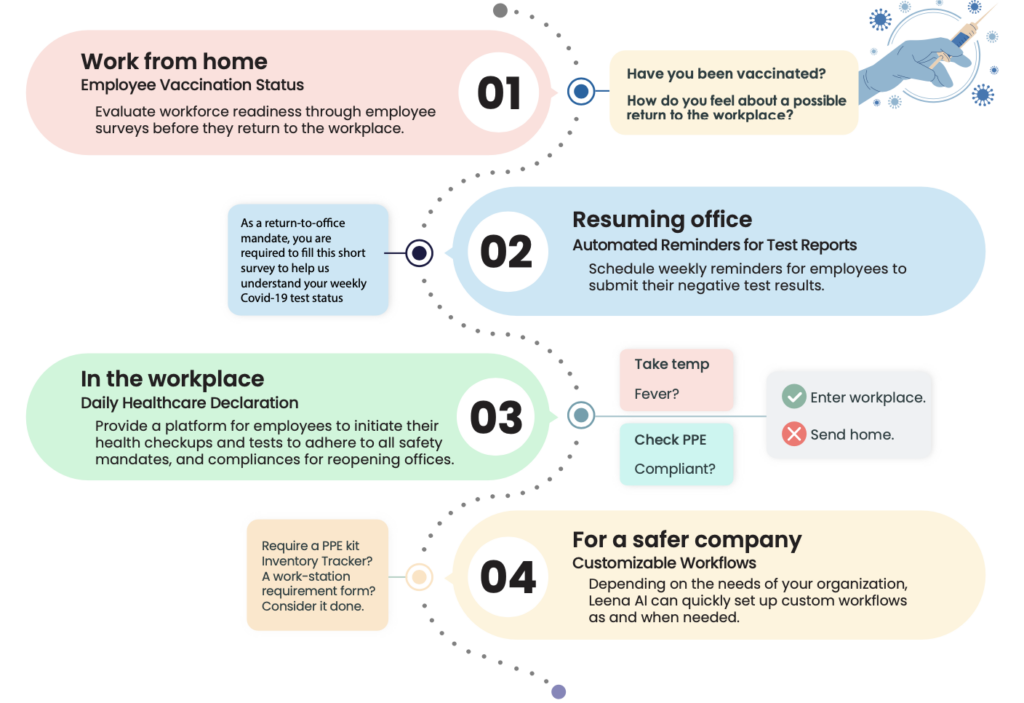
Bottom line
Currently, the future of work is shaped by two factors: the growing workforce willing to work in a hybrid framework and the adoption of artificial intelligence in the workplace. As companies have started to reopen their offices, employees are expected to return as soon as possible.
This makes it crucial for HRs to begin redefining work and health policies and ensuring a safe and productive environment for workers. They need to adopt AI technologies to automate employee workflows and query resolutions, providing them a positive experience.
Plus, organizations must also get their workers acquainted with the latest technologies across different processes to prevent AI from taking over their jobs altogether.
Want to give your employees the experience they deserve and be on top of their physical and mental health? Book a demo with Leena AI now to learn more.


